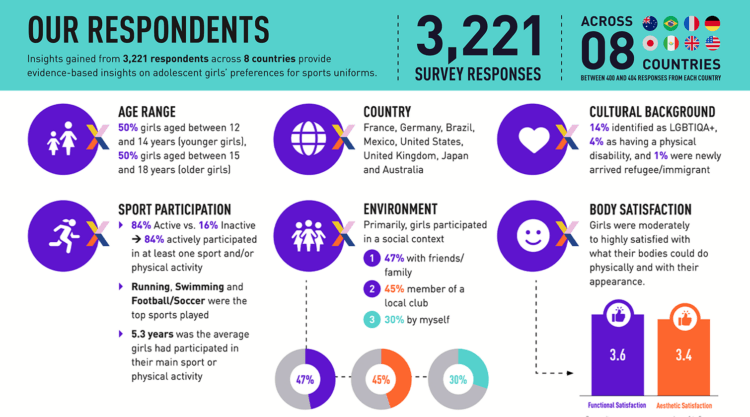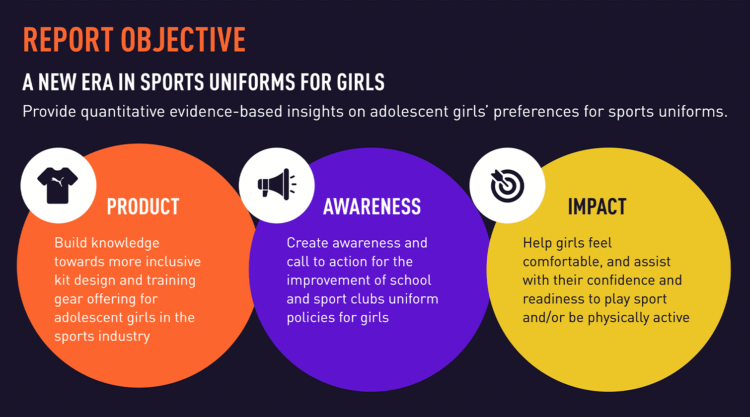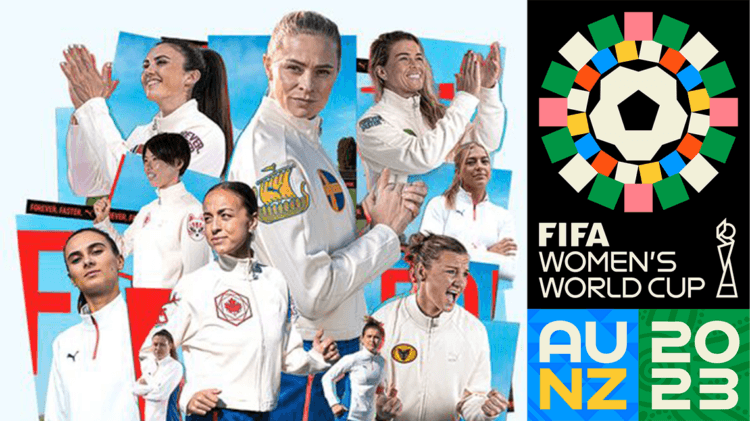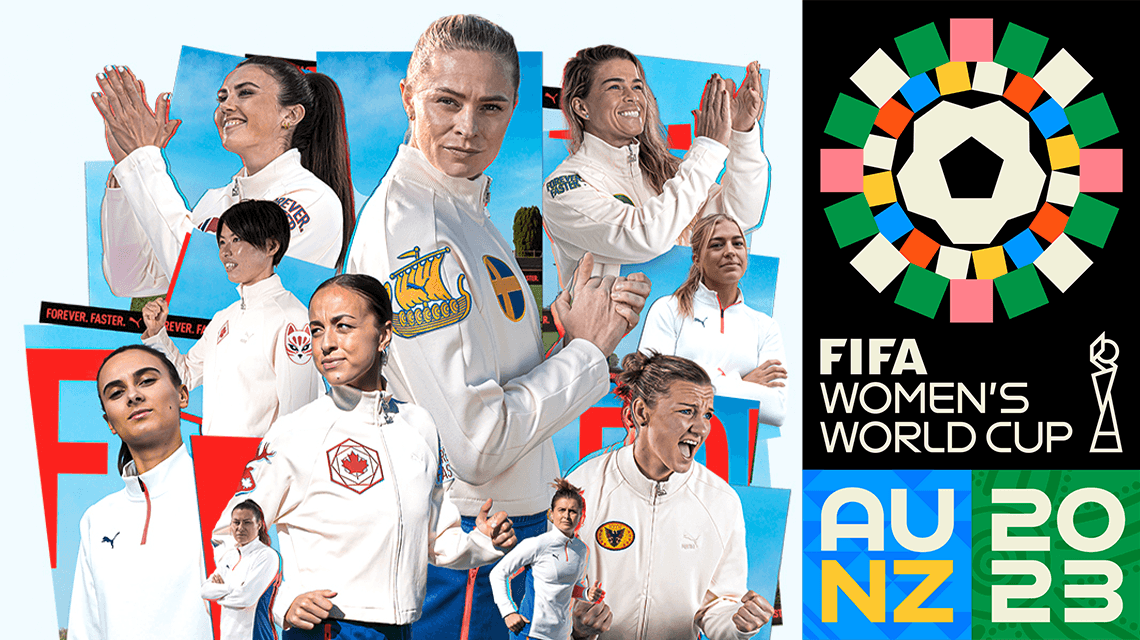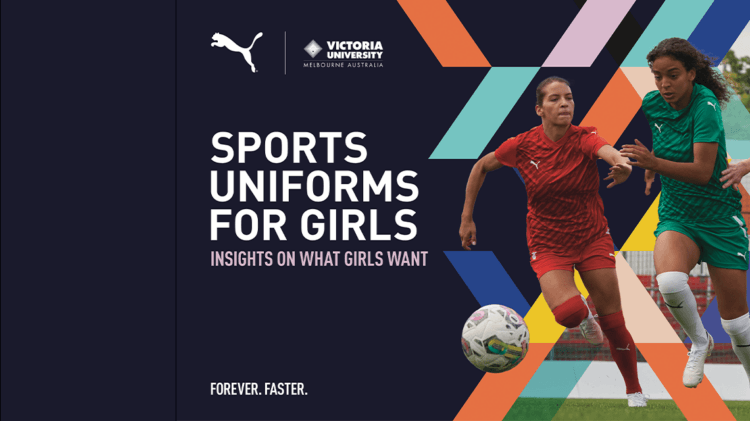
What Girls
Want
Interview with Professor Clare Hanlon on Her Study Concerning Sports Uniforms for Girls
July 21, 2023Interview with Professor Clare Hanlon on Her Study Concerning Sports Uniforms for Girls
July 21, 2023The women’s World Cup has kicked off in New Zealand and Australia this week, and CATch Up had the opportunity to sit down and chat with one women who advocates for females in sport: Clare Hanlon. A professor at Victoria University in Melbourne, Australia, Clare conducted a study in collaboration with PUMA to understand the aspects of sport uniforms that prevent or discourage girls from participating in sport.
PUMA teamed up with the Institute of Health and Sport at Victoria University to uncover girl’s preferences for sports uniforms in terms of aesthetics, comfort and performance. The study aims to help girls feel more comfortable and help them become more confident when playing sports by listening to what they want. This way, we can help influence how sports uniform are made for girls by tailoring them to their exact needs.
Read on to hear from Clare about the findings of the study and why they are so important.
Can you provide an overview of your study on sports uniforms for girls and its objectives?
Clare: We had over 3200 responses across eight countries from respondents and the objective was to gain evidence-based insights on, what do girls want for sport uniforms? What will encourage them to hopefully participate more in sport and physical activity?
What motivated you to undertake research specifically on girls’ sports uniforms?
Clare: Body dissatisfaction is common amongst adolescent girls, particularly 12- to 18-year-olds. And that could include fear of judgment: they’re feeling self-conscious about how they look and also about what they wear, which is why sport uniforms play a significant role. We also conducted an Australian study and the findings on the needs for girls were so obvious, that it was fantastic! PUMA reached out because they wanted to learn from a global context about what encourages girls to participate in sport and physical activity, and how influential sport uniforms are.
How did you gather data for your research? What methods or approaches did you employ?
Clare: PUMA contracted to a third party, Qualtrics, to recruit participants. They got the responses from parents who either completed the survey with or without their daughter. This was conducted across eight countries and approximately 400 respondents were gained from each country.
What were the key insights or findings that emerged from your study?
Clare: Girls know what they want. Girls want choice. There’s differences between age groups, there’s differences between countries, there’s differences between active and inactive girls. So based on these differences in their needs, that shows why choice is so important. And to provide sport uniforms, for example for active girls, the study showed 95% of active girls were happy to wear their sport uniforms. However, what we found was that 45% were conscious about what they wore, even though they were happy, they were conscious. And 16% felt that the uniforms restricted their movement and their performance. It’s important to know what it is that girls want: what choice do they want? What are the differences? But how can we cater for them?
But it also includes inactive girls who aren’t participating in physical activity. If they were to play, what would attract them? What type of outfits would attract them? That is a really important and interesting finding. For example, what we found was that nearly half of the inactive girls would pick up sport or physical activity if they could have the choice of their preferred uniform. Now it’s hard enough to get these inactive girls to play sport, but this just shows the influence sport uniforms have even to inactive girls.
Did you identify any significant differences in preferences or needs between girls of different age groups?
Clare: Yes! For example, we found the active younger girls (12 to 14) were more focused on what they wanted within themselves. They were more interested in sport uniforms that made them feel confident, that made them feel comfortable, and also that made them feel trendy. But then if you look at the older active girls, the 15- to 18-year-olds, they actually looked at it from a broader context. They were interested in sport uniforms where they didn’t feel exposed, but were also sustainable and they were concerned with the price.
Were there any surprising or unexpected findings that emerged from your study?
Clare: For me, it would be that three quarters of active girls responded saying their confidence and comfort would increase when playing sport if they wore their preferred uniform. Three quarters – that’s a lot. That shows the influence of sport uniforms. Also 70% said it would help them continue playing sport if they wore their preferred uniform. So that was important as well. A quarter of inactive girls would potentially start playing sport or physical activity if they wore their preferred uniform. So, sport uniforms have a lot to offer in relation to encouraging girls to continue playing, particularly if they feel comfortable – this applies to inactive girls too.
Girls, have a think about it: think about the last time you wore a piece of clothing that you didn’t feel comfortable in. Chances are you haven’t worn it again. You’ve recycled it or you’ve put it in the back of your cupboard. Now we’re expecting girls who don’t feel comfortable in their uniform to play sport week after week, and to turn up wearing that uniform. So, we need to turn around and create a care factor. To show that we care about what you need so you feel comfortable turning up in what you’re wearing.
What were some of the factors that influenced girls’ preferences for sports uniforms? Were there any specific elements that were particularly important to them?
Clare: They wanted uniforms where they felt comfortable, they wanted uniforms that would help with their performance. Apart from choice, they wanted gender specific uniforms and they didn’t want to feel exposed. Active girls wanted uniforms to be a tighter fit, where inactive girls wanted a looser fit. This is where you’ve got a difference between active and inactive girls. Active girls were happy to wear shorter t-shirts and shorts, whereas inactive girls were more interested to wear longer sleeves and longer pants. Again, it’s to hide their body in the sense of how they felt within themselves.
Did you identify any potential barriers or challenges that may prevent girls from participating in sports due to issues related to uniforms?
Clare: Yes, particularly for inactive girls. For example, some inactive girls just did not like sport full stop. But we also had responses that emphasised that the uniforms did not reflect their cultural beliefs – and that’s really important. Another variable was that they didn’t like the uniform, and that’s because there was only one uniform, one style, one design. That’s all you’ve got. And so it’s a matter of again, we keep going back to choice, in the context of what they like.
Another point in the context of trends and what girls liked, is that for active and inactive girls overall, they liked t-shirts, they liked bras the same color as their tops, they like to second layer. Now for a second layer that may be long sleeves under their t shirts. It may have been long pants under their shorts, but for others, the second layer might be that the shorts have two layers, so it’s a tighter fit underneath and then a looser fit over the top. So, second layers: what that means varies according to girls, but again, it’s providing that option of having a second layer.
In your opinion, how important is it to address the specific needs and preferences of girls when designing sports uniforms? Why?
Clare: I think based on what the findings have shown, this is a no brainer. We have to show a care factor. If sports, schools, brands want to show a care factor for girls and sport uniforms, we need to address what they need. We need to provide the choice, the variants. We need to acknowledge that differences do exist and that not one style fits all. That will then help girls feel that we’re listening to them and they feel they can participate, feeling comfortable and confident, knowing that they are wearing what they want. When we talk about choice, it may be that there’s a set choice of uniforms, or it may be that they have the freedom to wear whatever they want – providing it’s the same color as the club colors. If it’s a set choice, it needs to be the right choice. It’s no good if it doesn’t suit the needs of the girls.
Did you find cultural or regional variations in preferences for sports uniforms among girls?
Clare: That wasn’t a specific question that we asked in the study, but we did find, for example, that inactive girls didn’t participate in sport or physical activity because the uniforms did not reflect their cultural beliefs. It is really sad to think that they’re not playing sport because of that reason. So to address that, how many inactive girls can we then get to become active because we’re offering what they want? That would be pretty special.
We have to activate the findings from this study and apply it. PUMA has the care factor because they’ve reached out: they wanted to know what the needs of the girls are, what the differences are and how we can cater for them.
And so now with these findings, it’s now helping to educate schools and sports to say this is what girls want. And I think that’s a really great tool that PUMA has moving forward to help educate society.
Were there any limitations or areas where further research is needed to deepen our understanding of girls’ preferences for sports uniforms?
Clare: I think for further research, we need to dig deeper into sports, whether that be individual sports or team sports. What do girls want within a sport? Also, in the context of what does sustainability and price look like for older girls? Because they said this was really important for them. But what does that mean? To unpack everything would be very interesting.
Based on your research, what are your recommendations for PUMA regarding the design and provision of sports uniforms for girls?
Clare: First of all, for PUMA to improve their kit design and training outfits based on these findings in a way that offers choice, looser and tighter fits, round necks, collars, v necks – having a variance is really important. I think a really great opportunity here is for PUMA to showcase that they may have a team of girls, they may have older girls, younger girls, they may have inactive girls, they may have active girls – but they are all wearing different types of outfits that they feel comfortable in. It may be the same team colors, but again, it varies. It shows that PUMA cares, regardless of age, regardless of cultural beliefs and so on.
It’s so easy to forget about inactive girls, yet there are so many out there and they want to play. They want to participate. If they do, how can we help them? And sport uniforms is one way that we can help.
